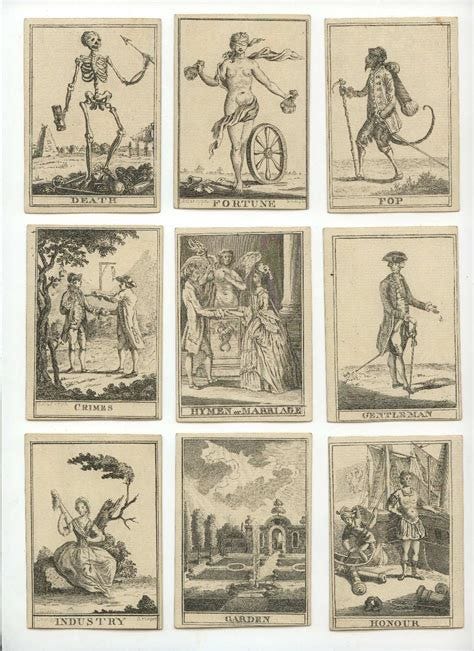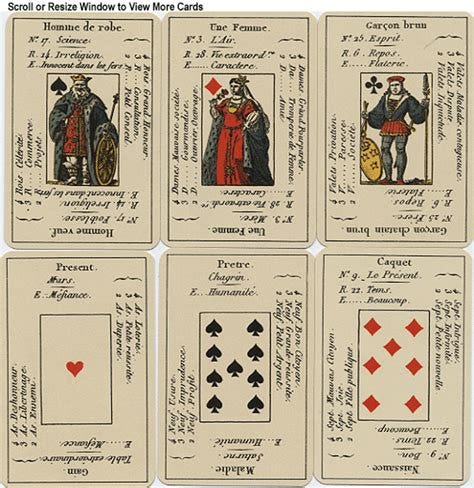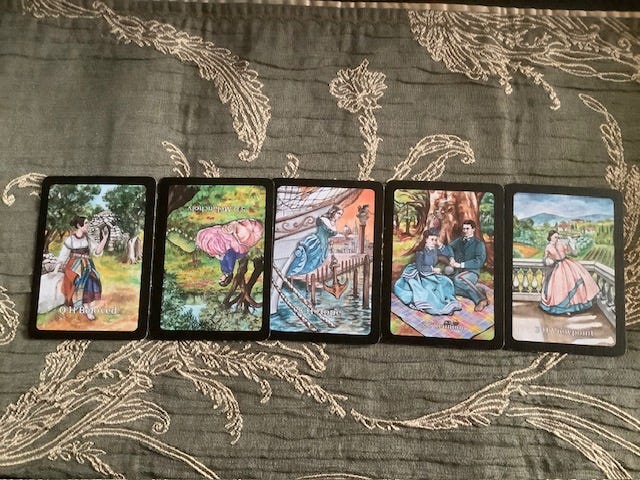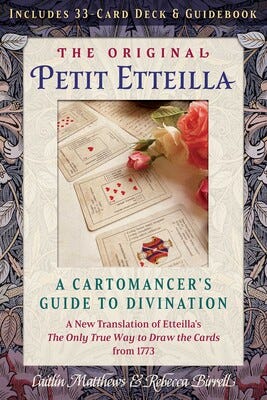WHAT IS THE VERA SIBILLA?
Later this summer, I have the first English-language Vera Sibilla learner’s book and a new deck of Vera Sibilla cards by Anastasia Kashian coming out from RedFeather. You may not have encountered these cards before, so here is a little introduction to them.
The Vera Sibilla oracle is a small 52 card divination deck from Italy, one of several 19th century cards. From the late 18th century across Europe there arose a swathe of small oracle cards which are generally called ‘les petits jeux’ (small games) in France. This movement derived its origin from two sources. The first was the inspiration of a set of S. Hooper’s Conversation Cards – cards with images of everyday people, things and circumstances, which appeared in Britain in the mid 18th century. These ‘conversation cards’ were originally intended as part of a drawing room game where people round the table drew a card and made a continuous story. Several kinds of cards like this had been circulating for a while, but from the time of the Napoleonic wars onwards, they proliferated across Europe, only now they moved from being a parlour game of storytelling into a way of reading fortunes.
Here we see some of the standard ‘conversation cards’ which continued to be reproduced for some centuries: Death, Fortune, Hymen/Marriage, Gentleman, Garden and Criminality. Variations upon these topics can still be found in Lenormand, Kipper and Sibilla decks.
The second source of the petit jeux phenomenon was the turbo-charge blast of inspiration set off when Etteilla (Jean-Baptiste Alliette, 1738-91) published his book Etteilla, ou maniere de se récréer avec un jeu de cartes - Etteilla, or How to Recreate Yourself With Cards.) in 1770.* This book was the very first ‘how to divine with cards’ book ever written, enabling anyone with a pack of playing cards to create from it a divination oracle, now called Le Petit Etteilla, from a stripped or shortened deck of 32 cards. It is called ‘the Little Etteilla’ to distinguish it from the later 78 card eclectic and esoteric tarot which is known as Le Grand Etteilla, or the Big Etteilla! Here we see Professional Man, A Woman, Brunette Youth, Now, Priest and Gossip, but their reversed meanings are very different, and all the instructions for reading are written upon the card.
Soon enough, there were many little oracle decks being printed, most of them followed the appearance of the Conversation cards, with images of characters and situations, but all of them also followed Etteilla’s lead by becoming cards you could divine from! Lenormand began in Germany and France, Kipper in Germany, and a new brand of card, Sibillas, spread from France into the Austro-Hungarian Empire where these cards were called Zigeuner Karten or ‘Gypsy Cards,’ and lastly into Italy, which was still part of that empire, where they emerged as Vera Sibilla, or ‘the Real Sibyl.’ A lot of these decks began with 32-36 cards, but Vera Sibilla particularly evolved finally into a 52-card deck.
A 1850 32-card Vera Sibilla now available as Antica Sibilla Italiana (Lo Scarabeo) showing Sickness, Soldier and Gift of Jewels
The Vera Sibilla crashed bang into the Risorgiomento of Italy’s reunification period, when Garibaldi was trying to restore Italy to one country, rather the rag-bag of city-states or regions governed by local, papal or foreign powers – a process that finally took till 1919, but was mostly done by 1870.

Up until the present times, it has been very difficult to learn much about Vera Sibilla as most of the books are only published in Italian, but my Magic Lantern Sibilla is going to change all that. I am hoping that the book and cards will enable you to learn and use the cards with confidence. Just as my book, the Complete Lenormand Oracle Handbook enabled readers to learn Lenormand reading, which had largely been only in German and French up till the 2010s, so now I am introducing the Vera Sibilla to English-speaking diviners for the first time, giving progressive learning opportunities, self-tests, and a programme of deeper engagement with the cards.
WHAT IS DIFFERENT ABOUT VERA SIBILLA READING?
While there are similar subjects on the many European petit jeux (or small oracle) cards, but we have to note that Italian Vera Sibilla is not read in the same way as either Lenormand, nor even like Kipper, and that the Italian SIbillas even have their own regional differences from other European Sibilla cards. If you already possess cartomantic reading skills, you will get on better than trying to read these cards like a tarot, because they belong to an earlier, cartomantic style of reading where the picture on the card is not the whole story, but rather just an indicator of a raft of more meanings. Vera Sibilla has its own language and character. Also, we can read the 52 cards both upright and reversed: which means you need to learn all the meanings - there is no option to just read upright cards - although in The Magic Lantern Sibilla which is coming this summer, you are gently introduced to reversed reading.
As you can see below, Vera Sibilla is usually read in lines of odd numbers: 3, 5, 7, 9, with the hinge card at the centre of the line, around which the theme question hinges, and two outer cards acting as the pillars or doorkeepers of the questions. We read the hinge and pillars together with the hinge card to understand if the cards in these positions are resonant with the question asked. If they are not, then the cards are likely to be talking about something else in the querent’s mind.
This is one of the features of Vera Sibilla whose cards have been called Chiaccherine or ‘chatterboxes,’ because of their singular habit of talking about anything that is in the querent’s mind, even when they have asked a specific question. These Vera Sibilla cards are as nosy, and sometimes as loud, as women gossiping around the village green. And while you can ask the cards a yes/no question like ‘Will I get to Paris this summer?’ or a general predictive question, you will probably not get anything like advice from them if you ask, ‘What should I do about Albert’s bicycle?’ because the cards will only speak about what Albert is actually doing not what you should or could do. Let’s ask these two questions, so you can see what I mean. I’ve just put some context in brackets after each question to help us along.
‘Will I get to Paris this summer?’ (You’ve wanted to see the Louvre since time began, but never had the time or money.) NOTE, that the cards shown here are from a practice pack that I had made: the published cards have clear titles and suits on them, as you can see from the ones heading this post! It is not possible to lay 5 cards abreast in the Substack format, and I don’t have the published cards myself at this point.
Looking at the hinge (the centre card) and pillar (beginning and end) cards for a sense of whether the cards are speaking about the question, we find that they are consistent: Hope is a card of travel & holiday, as well as hopes fulfilled, so it’s bang on the topic, Beloved and Viewpoint show us the woman who wants to go, and the card of long-distance travel which is coming towards her. So, we already have the basis of a good answer for her. Reversed Melancholy suggests some delay or a sense of the woman still being affected by past conditions, while Reunion speaks of a healing and restoration of hope. To confirm this, I look at the suits of the pillars – they are both Hearts, so I would say, yes she will most likely go to Paris, though it might be a little later than planned – possibly in the autumn.
So, let’s look at that advice question: ‘What should I do about Albert’s bicycle?’ (Your lodger has gone away and left his bicycle in your hallway; it is deeply inconvenient. He is not contactable and now owes you back rent also!)
We check the hinge and the pillars for some clues to whether these cards answer the question. Levity is impulsiveness and the kind of inattention that has bad consequences. Reversed Soldier and Reversed Falsehood indicate Albert doing something covert or secret, and the revelation of his plots, plans or lies. This is clearly talking about Albert and not about what to do with the bicycle. Do we continue to read, because it looks as if the cards are gossiping about him? Diviners have the dilemma about third party readings drawn about someone else, but without their consent, but here the cards are not answering the set question, they are discussing Albert, not his bicycle. For the sake of explanation I will push on.
The other two cards rev. Pride and Room give us a rather ghastly image: the first is the primary card of the evil-eye or looking with jealous eyes upon what someone else has; since the reversed card of Room is about one’s private space, insider knowledge and personal information being breached, I draw the following meaning: Albert is doing something undercover, possibly some covert surveillance, but with the greatest of opportunistic ease; he’s been listening into some private details but his lying and fraudulent ways are going to be unmasked. (While this may be why he has not come back, and we might see prison looming for him as a result, it tells us absolutely nothing about what to do with the bicycle!)
Here, we see both the bravura indifference of Vera Sibilla, and the way in which it actually gives a respectful boundary to the querent: you cannot just offload your difficult decisions onto the oracle here! Vera Sibilla makes you an active partner in the divination, and so your question needs to be a lot sharper than the Albert’s bicycle one. ‘Should' makes a lazy question, conditional upon some kind of approbation of an exterior agency. It tries to by-pass personal responsibility. Better questions might be to ask 'What will result if I put Albert’s bicycle in the garden?' or 'what are the consequences of selling it to cover his back rent?’ Let’s ask that last question!
What are the consequences of selling Albert’s bicycle to cover his back rent? (Because now you waited months to remove the thing from your hallway, and you need the cash!)
Well, here’s an amazing answer – the line begins and ends with the best cards in the pack Fortune and Pride, with the hinge of Comforting Surprise telling us that material satisfaction will be guaranteed – we almost don’t need to read onwards, but I will. Reversed Lady sees the querent as a woman undergoing disadvantages, but Love is liking her spirit. In order, the line reads: material success for the put-upon woman, material satisfaction soon, and she will enjoy this guaranteed reward without consequences, because Pride is the last card, and when it ends a line, it blesses you properly. If we needed any further confirmation, then we have two clubs as pillars, meaning this is a helpful and practical solution. Hurrah!
I will return with some more occasional glimpses of the new Magic Lantern Sibilla in action. If you want to preorder a deck, it is coming this summer.
My own edition and translation of Etteilla’s 1772 book is coming out 9 December 2025 as ‘The Original Petit Etteilla.’ With a new deck by Rebecca Birrell, from Inner Traditions. https://www.simonandschuster.com/books/The-Original-Petit-Etteilla/Caitlin-Matthews/9798888503010
The Magic Lantern Sibilla by myself and cards by Anastasia Kashian is out in August. 2025 in UK and June in US. It comes with 52 Cards and a comprehensive and progressive learning programme book for Sibilla beginners.
https://schifferbooks.com/products/the-magic-lantern-sibilla?srsltid=AfmBOoqiTaAdVOMcD_CQXgViKsKpaXSLcQGwnoTyoV7IWME_ALK8_D1L
https://www.amazon.co.uk/Magic-Lantern-Sibilla-384-page-Guidebook/dp/0764368974/ref=sr_1_1?crid=2EFJ8W0RMN8PT&dib=eyJ2IjoiMSJ9.Qj9bPZ4gxtHUWtzIUzzE77YdXiu_o3DGwCf-hWgMXakwGyh8ZfkSCcsTXLjkDuThZx1gtHNXB6D8qyYBYSnsmHfklHJlEQImpjh_9Nn_Kc4.a2jakugu6poVCPS1jY1x5we1-iu9bpyN03YvkgzBpQ0&dib_tag=se&keywords=magic+lantern+sibilla&qid=1743182684&sprefix=Magic+Lantern%2Caps%2C103&sr=8-1
Anastasia and myself will both be speaking at the TABI Conference (Tarot Association of Britain and International Readers) in Manchester on 26-7 July 2025. Tickets for in person or online attendance are available now. https://tabi.org.uk/tabi-conference_/
















That was fascinating, particularly your commentary about good and bad ways of framing questions. Arguably thoughts to consider in any divination system!
I am looking forward to getting your Vera sibilla when it comes out, I love the way these little fortune telling oracle decks read!